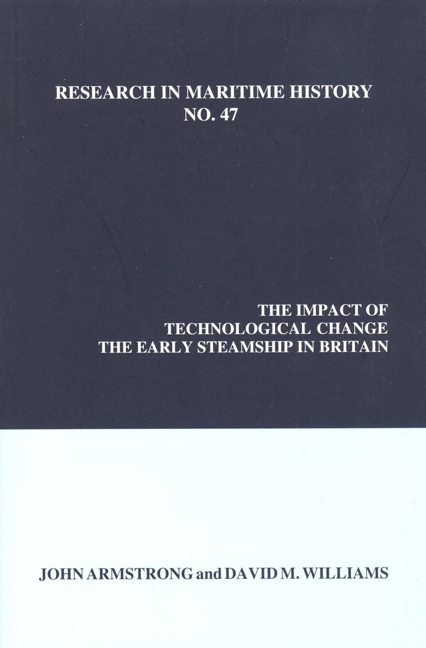Book contents
- Frontmatter
- Contents
- Series Editor's Foreword
- About the Authors
- Introduction
- Chapter 1 British Steam Navigation, 1812 to the 1850s: A Bibliographical and Historiographical Review
- Chapter 2 Some Official Listings of “Vessels Navigated by Steam” in Britain up to 1851: Evidence and Interpretation
- Chapter 3 The Steamboat, Safety and the State: Government Reaction to New Technology in a Period of Laissez-Faire
- Chapter 4 The Steamboat and Popular Tourism
- Chapter 5 The Thames and Recreation, 1815-1840
- Chapter 6 Steam Shipping and the Beginnings of Overseas Tourism: British Travel to North Western Europe, 1820-1850
- Chapter 7 Technological Advance and Innovation: The Diffusion of the Early Steamship in the United Kingdom, 1812-1834
- Chapter 8 The Steamship as an Agent of Modernisation, 1812-1840
- Chapter 9 “A New and Very Modern Business:” The Traffic and Operations of the Early Steamship
- Chapter 10 Promotion, Speculation and Their Outcome: The “Steamship Mania” of 1824-1825
- Chapter 11 The Perception and Understanding of New Technology: A Failed Attempt to Establish Transatlantic Steamship Liner Services, 1824-1828
- Chapter 12 The “Norwich Explosion” of 1817: A Local Tragedy of National Significance
- Chapter 13 Early Steamboat Services and Their Impact in North Wales, 1817-1840s
- Chapter 14 The Beginnings of a New Technology: The Constructors of Early Steamboats, 1812-1822
Chapter 10 - Promotion, Speculation and Their Outcome: The “Steamship Mania” of 1824-1825
- Frontmatter
- Contents
- Series Editor's Foreword
- About the Authors
- Introduction
- Chapter 1 British Steam Navigation, 1812 to the 1850s: A Bibliographical and Historiographical Review
- Chapter 2 Some Official Listings of “Vessels Navigated by Steam” in Britain up to 1851: Evidence and Interpretation
- Chapter 3 The Steamboat, Safety and the State: Government Reaction to New Technology in a Period of Laissez-Faire
- Chapter 4 The Steamboat and Popular Tourism
- Chapter 5 The Thames and Recreation, 1815-1840
- Chapter 6 Steam Shipping and the Beginnings of Overseas Tourism: British Travel to North Western Europe, 1820-1850
- Chapter 7 Technological Advance and Innovation: The Diffusion of the Early Steamship in the United Kingdom, 1812-1834
- Chapter 8 The Steamship as an Agent of Modernisation, 1812-1840
- Chapter 9 “A New and Very Modern Business:” The Traffic and Operations of the Early Steamship
- Chapter 10 Promotion, Speculation and Their Outcome: The “Steamship Mania” of 1824-1825
- Chapter 11 The Perception and Understanding of New Technology: A Failed Attempt to Establish Transatlantic Steamship Liner Services, 1824-1828
- Chapter 12 The “Norwich Explosion” of 1817: A Local Tragedy of National Significance
- Chapter 13 Early Steamboat Services and Their Impact in North Wales, 1817-1840s
- Chapter 14 The Beginnings of a New Technology: The Constructors of Early Steamboats, 1812-1822
Summary
Occasionally, in the process of research instances arise where, from the original starting point and thesis, the direction of research shifts so dramatically as to warrant an account of how a paper came to be written. The authors of this paper believe that the twists and turns in the research process underlying this study may prove of interest. Our experience reveals how an initial hypothesis can prove to be totally incorrect and result in its authors being faced with a search for explanations of developments and outcomes that were the complete reverse of those envisaged.
In this instance, the starting point was a different study on which we were engaged, that of the diffusion of the steamship in the two decades or so following the pioneering voyage of Comet in 1812. High among the factors that influenced diffusion were the steamship's special qualities compared with sail: greater speed and the ability to progress against adverse winds and tides that enabled faster and predictable journey times and operation to a schedule. Offsetting such superior features was the need to give up much cargo space to engines, boilers and fuel bunkers, and the higher costs both of construction and operation. One outcome of these higher costs, especially in the long run, was that steamship companies came to be financed through joint-stock organization. Upon consulting an important study of ship ownership, we discovered a reference to the promotion of sixty-seven joint-stock shipping companies in 1824-1825. Such a flush of promotions immediately evoked parallels with two other transport-associated bursts of promotional and speculative activity, the Canal Mania of the early 1790s and the Railway Manias of the 1830s and 1840s. These occurrences have been the subject of extensive consideration by transport and financial historians, but nowhere in our research had we ever seen reference to a “steamship mania.” Here was a new, exciting theme to investigate. What were the causes of the mania, what form did it take, who were the companies and parties involved and what was its outcome and significance? Moreover, it would seem that this spurt of activity in 1824-1825 would have a significant bearing on our study of the pace and form of the diffusion of the steamship.
- Type
- Chapter
- Information
- The Impact of Technological ChangeThe Early Steamship In Britain, pp. 205 - 224Publisher: Liverpool University PressPrint publication year: 2011



